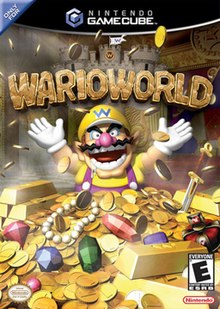
Dr. Mario is a 1990 puzzle video game developed and published by Nintendo for the Nintendo Entertainment System, Famicom, and Game Boy. It was produced by Gunpei Yokoi and designed by Takahiro Harada. The soundtrack was composed by Hirokazu Tanaka.
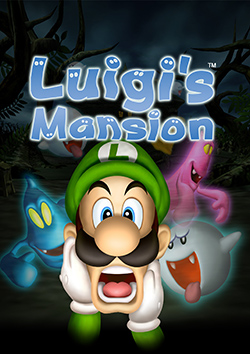
Luigi's Mansion is a 2001 action-adventure game developed and published by Nintendo. The game was a launch title for the GameCube and was the first game in the Mario franchise to be released for the console; it was released in Japan on September 14, 2001, in North America on November 18, 2001, in Europe on May 3, 2002, and in Australia on May 17, 2002. It is the third video game in which Luigi is the main character instead of Mario, after Mario Is Missing! and Luigi's Hammer Toss. Players control him as he explores a haunted mansion, searches for Mario and deals with ghosts by capturing them through a vacuum cleaner supplied by Professor E. Gadd.

Waluigi is a character in the Mario franchise. He plays the role of Luigi's arch-rival and accompanies Wario in spin-offs from the main Mario series, often for the sake of causing mischief. He was created by Camelot employee Fumihide Aoki and was voiced from 2000 to 2022 by Charles Martinet, who described Waluigi as someone with a lot of self-pity. Waluigi's design is characterised by his tall stature, thin and lanky frame, and his purple and black outfit with purple hat, which displays an inverted yellow "L".

Wario is a character in Nintendo's Mario video game series that was designed as an archnemesis to Mario. Wario first appeared as the main antagonist and final boss in the 1992 Game Boy game Super Mario Land 2: 6 Golden Coins. His name is a portmanteau of the name Mario and the Japanese word warui, meaning "bad". He is usually portrayed as a greedy treasure hunter who routinely loses the treasure or artifacts he ultimately finds. Since his debut, he has appeared in the majority of Mario video games. Hiroji Kiyotake designed Wario, and Charles Martinet voiced the character from 1993 to 2023.
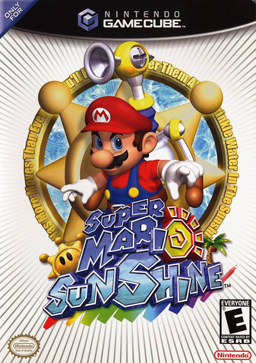
Super Mario Sunshine is a 2002 platform game developed and published by Nintendo for the GameCube. It is the second 3D game in the Super Mario series, following Super Mario 64 (1996). The game was directed by Yoshiaki Koizumi and Kenta Usui, produced by series creators Shigeru Miyamoto and Takashi Tezuka, written by Makoto Wada, and scored by Koji Kondo and Shinobu Tanaka.

Mario Party 4 is a 2002 party video game developed by Hudson Soft and published by Nintendo for the GameCube. The game is the fourth installment in the Mario Party series and is the first game in the series to be released for the GameCube. Like the previous games in the series, it features eight playable characters: Mario, Luigi, Princess Peach, Yoshi, Wario, Donkey Kong, Princess Daisy, and Waluigi from the Mario franchise, who can be directed as characters on 6 themed game boards. The objective is to earn as many stars as possible, which are obtained by purchase from a single predefined space on the game board. Each character's movement is determined by a roll of a die, with a roll from each player forming a single turn. Each turn is followed by a minigame in which characters compete for coins they can use to purchase items and stars.

Mario Party 5 is a party video game developed by Hudson Soft and published by Nintendo for the GameCube. It is the fifth installment in the Mario Party series and the second game in the series to be released for the GameCube. It was first released in North America and Japan in November 2003, followed by Europe a month later. The game is set in the fictional Dream Depot, consisting of seven game boards. The single-player "Story" mode involves the player winning multiple games against the Koopa Kids to prevent Bowser from conquering the Dream Depot. The main multiplayer game mode consists of four characters from the Mario series playing a board game, with each board having a set theme. The game also features several minigames, which are played after every set of turns. Mario Party 5 introduces the "Super Duel" mode to the franchise, which requires players to assemble and control custom made battle vehicles which can be used in combat against other machines. The game features ten playable characters, with playable debuts to the series from Toad, Boo, and Koopa Kid.

Wario's Woods is a puzzle video game developed by TEC and published by Nintendo for the Nintendo Entertainment System. It was released in Japan and North America in 1994 and Europe in 1995. A spin-off of the Mario series, players control Toad in his mission to defeat Wario, who has taken control of the Peaceful Woods. Gameplay revolves around clearing each level by using bombs to destroy groups of enemies. The game also features a multiplayer mode that allows two players to compete against each other.

Mario Golf: Toadstool Tour, known in Japan as Mario Golf: Family Tour, is a 2003 sports game developed by Camelot Software Planning and published by Nintendo for the GameCube. It is the sequel to the 1999 Nintendo 64 title Mario Golf, and is the third game in the Mario Golf series. It was released in North America on July 28, 2003, in Japan on September 5, 2003, and in PAL regions in 2004.
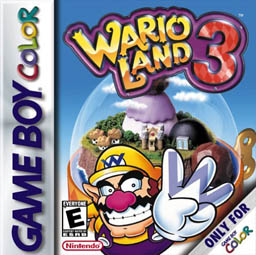
Wario Land 3 is a platform game developed and published by Nintendo for the Game Boy Color. In the game, Mario's archrival Wario must free a mysterious figure who is trapped inside a music box. It was followed by Wario Land 4 in 2001. It was also released for the Nintendo 3DS Virtual Console in 2013, and as part of the Nintendo Switch Online service on 8 February 2023.

Wario Land 4 is a 2001 platform game developed by Nintendo and released for the Game Boy Advance. Wario has to gather four treasures to unlock a pyramid and save Princess Shokora from the Golden Diva.

Super Mario 64 DS is a 2004 platform game developed and published by Nintendo for the Nintendo DS. It was a launch game for the DS. Super Mario 64 DS is a remake of the 1996 Nintendo 64 game Super Mario 64, with new graphics, characters, collectibles, a multiplayer mode, and several extra minigames. As with the original, the plot centers on rescuing Princess Peach from Bowser. Unlike the original, Yoshi is the first playable character, with Mario, Luigi, and Wario being unlockable characters in early phases of the game.

Paper Mario: The Thousand-Year Door is a 2004 role-playing game developed by Intelligent Systems and published by Nintendo for the GameCube. The Thousand-Year Door is the second game in the Paper Mario series following Paper Mario, and is part of the larger Mario franchise. In the game, when Mario and Princess Peach get involved in the search for a mystic treasure that holds great fortune, Peach is kidnapped by an alien group called the X-Nauts; Mario sets out to find the treasure and save the princess.
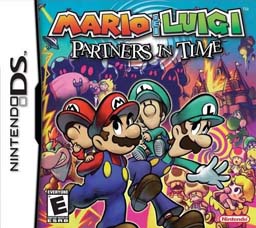
Mario & Luigi: Partners in Time is a role-playing video game developed by AlphaDream and published by Nintendo for the Nintendo DS handheld game console in late 2005. It is the second game in the Mario & Luigi series, and is the prequel/sequel to the 2003 Game Boy Advance game Mario & Luigi: Superstar Saga. The game was later re-released for the Wii U as a Virtual Console title in 2015, available for purchase from the Nintendo eShop.

Virtual Boy Wario Land is a 1995 platform video game developed and published by Nintendo for the Virtual Boy. It stars Wario, who finds himself deep underground after stumbling upon a treasure-filled cave and must find his way back to the surface. Throughout the journey, the player explores and searches for items and power-ups while fighting enemies and defeating bosses. Wario has the ability to jump between the background and foreground at certain points, making use of Virtual Boy's stereoscopic 3D effect.

Yoshi's Island DS, known in Japan as Yoshi Island DS, is a 2006 platform game developed by Artoon and published by Nintendo for the Nintendo DS. It was released in North America and Australia in November 2006, in Europe in December 2006, and in Japan in March 2007. It is a sequel to the 1995 SNES game, Super Mario World 2: Yoshi's Island. Announced at Nintendo's E3 press conference in May 2006, the game was well received by critics, scoring an average of 81% on Metacritic's aggregate. The game was originally to be titled Yoshi's Island 2, though its name was changed one month before its North American release. In April and May 2015, the game was made available for the Wii U via the Virtual Console service, shortly after a Nintendo Direct presentation.

WarioWare: Smooth Moves is a party video game developed by Nintendo SPD and Intelligent Systems. The game was published by Nintendo for its Wii video game system in Japan in December 2006, and in Europe, North America, and Australia in January 2007. It is the fifth game in the WarioWare series of games, and the only game in the series to be physically released for the Wii. Like its predecessors, WarioWare: Smooth Moves is built around a collection of microgames that last about five seconds each, and which require that the player hold the Wii Remote in specific positions. The game offers the microgames to the player in rapid succession, by first instructing the player to hold the Wii Remote in a specific manner, and then showing them the microgame. The microgames are divided into several stages, each of which loosely connects the microgames with the help of a story. Additionally, this was the first spin-off Mario game to be released for the console.

New Super Mario Bros. Wii is a 2009 platform game developed and published by Nintendo for the Wii. A follow-up to New Super Mario Bros., it was first released in Australia, North America, and Europe in November 2009, followed by Japan a month later. A high-definition port for the Nvidia Shield TV was released in China in December 2017. Like other side-scrolling Super Mario games, the player controls Mario as he travels eight worlds and fights Bowser's henchmen to rescue Princess Peach. New Super Mario Bros. Wii was the first Super Mario game to feature simultaneous cooperative multiplayer gameplay; up to four people can play in cooperative and competitive multiplayer modes, taking control of Mario as well as Luigi and one of two multicolored Toads. The game also introduced "Super Guide", which allows the player to watch a computer-controlled character complete a level.
